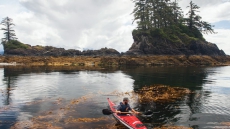VICTORIA — Health officials are offering some food safety advice as this year's herring egg harvest opens along a section of Vancouver Island's east coast.
Hand-gathered herring eggs, known as spawn-on-kelp, are an important traditional seafood for many First Nations, but an outbreak of a cholera strain in 2018 forced closure of the harvest between French Creek and Qualicum Bay.
Island Health says in a news release that lab tests confirm a small group of people contracted the vibrio cholera bacteria last year after eating herring eggs from the affected region.
Officials say the bacteria are a "natural inhabitant" of the marine environment, are unable to produce the toxin found in more severe strains of cholera and are not from poor sanitation or sewage.
Vibrio cholera infections are relatively rare, but the health authority says when they do occur symptoms can include diarrhea, abdominal cramps, fever, vomiting, nausea, blood and mucus of the stool.
Until last year there had been no reported outbreaks, but a Health Canada and BC Centre for Disease Control review found salinity, acidity, temperature, sunlight and availability of nutrients can encourage the bacteria.
Water temperature above 10 C and sea water low in salt are two key factors in development of vibrio cholera, the review said.
"At the time of the March 2018 harvest, although water temperatures were below 10 degrees C, a relatively high rainfall could have affected different environmental factors, including lowering salinity and increasing nutrient availability," it said.
The health authority urges harvesters to use bleach or a similar sanitizer on all harvesting and egg-carrying equipment, to wash hands before handling roe and to rinse the eggs with drinking-quality water or boiled, cooled salt water to remove some bacteria.
It also recommends the roe be cooked or blanched, but "if cooking is not preferred, be aware that there is always a risk with eating raw seafood."
Vibrio cholera is an emerging issue on the B.C. coast, the news release says, adding that First Nations, health authorities and the federal and provincial governments are working to better understand it.



